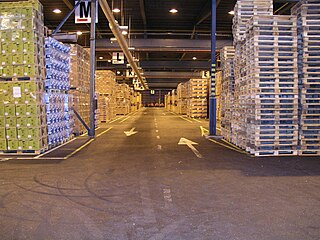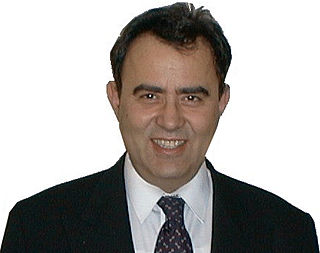
Probability is the branch of mathematics concerning events and numerical descriptions of how likely they are to occur. The probability of an event is a number between 0 and 1; the larger the probability, the more likely an event is to occur. A simple example is the tossing of a fair (unbiased) coin. Since the coin is fair, the two outcomes are both equally probable; the probability of "heads" equals the probability of "tails"; and since no other outcomes are possible, the probability of either "heads" or "tails" is 1/2.

Seismology is the scientific study of earthquakes and the generation and propagation of elastic waves through the Earth or other planetary bodies. It also includes studies of earthquake environmental effects such as tsunamis as well as diverse seismic sources such as volcanic, tectonic, glacial, fluvial, oceanic microseism, atmospheric, and artificial processes such as explosions and human activities. A related field that uses geology to infer information regarding past earthquakes is paleoseismology. A recording of Earth motion as a function of time, created by a seismograph is called a seismogram. A seismologist is a scientist works in basic or applied seismology.

A semantic network, or frame network is a knowledge base that represents semantic relations between concepts in a network. This is often used as a form of knowledge representation. It is a directed or undirected graph consisting of vertices, which represent concepts, and edges, which represent semantic relations between concepts, mapping or connecting semantic fields. A semantic network may be instantiated as, for example, a graph database or a concept map. Typical standardized semantic networks are expressed as semantic triples.

In probability theory and related fields, a stochastic or random process is a mathematical object usually defined as a sequence of random variables in a probability space, where the index of the sequence often has the interpretation of time. Stochastic processes are widely used as mathematical models of systems and phenomena that appear to vary in a random manner. Examples include the growth of a bacterial population, an electrical current fluctuating due to thermal noise, or the movement of a gas molecule. Stochastic processes have applications in many disciplines such as biology, chemistry, ecology, neuroscience, physics, image processing, signal processing, control theory, information theory, computer science, and telecommunications. Furthermore, seemingly random changes in financial markets have motivated the extensive use of stochastic processes in finance.
Geostatistics is a branch of statistics focusing on spatial or spatiotemporal datasets. Developed originally to predict probability distributions of ore grades for mining operations, it is currently applied in diverse disciplines including petroleum geology, hydrogeology, hydrology, meteorology, oceanography, geochemistry, geometallurgy, geography, forestry, environmental control, landscape ecology, soil science, and agriculture. Geostatistics is applied in varied branches of geography, particularly those involving the spread of diseases (epidemiology), the practice of commerce and military planning (logistics), and the development of efficient spatial networks. Geostatistical algorithms are incorporated in many places, including geographic information systems (GIS).

Ross John Anderson was a British researcher, author, and industry consultant in security engineering. He was Professor of Security Engineering at the Department of Computer Science and Technology, University of Cambridge where he was part of the University's security group.

Uncertainty or incertitude refers to epistemic situations involving imperfect or unknown information. It applies to predictions of future events, to physical measurements that are already made, or to the unknown. Uncertainty arises in partially observable or stochastic environments, as well as due to ignorance, indolence, or both. It arises in any number of fields, including insurance, philosophy, physics, statistics, economics, finance, medicine, psychology, sociology, engineering, metrology, meteorology, ecology and information science.

Sir Harold Jeffreys, FRS was a British geophysicist who made significant contributions to mathematics and statistics. His book, Theory of Probability, which was first published in 1939, played an important role in the revival of the objective Bayesian view of probability.
Computational science, also known as scientific computing, technical computing or scientific computation (SC), is a division of science that uses advanced computing capabilities to understand and solve complex physical problems. This includes

The Ross–Littlewood paradox is a hypothetical problem in abstract mathematics and logic designed to illustrate the paradoxical, or at least non-intuitive, nature of infinity. More specifically, like the Thomson's lamp paradox, the Ross–Littlewood paradox tries to illustrate the conceptual difficulties with the notion of a supertask, in which an infinite number of tasks are completed sequentially. The problem was originally described by mathematician John E. Littlewood in his 1953 book Littlewood's Miscellany, and was later expanded upon by Sheldon Ross in his 1988 book A First Course in Probability.

Philip Mayne Woodward was a British mathematician, radar engineer and horologist. He achieved notable success in all three fields. Before retiring, he was a deputy chief scientific officer at the Royal Signals and Radar Establishment of the British Ministry of Defence in Malvern, Worcestershire.
Ian Munro Ross FREng was an early pioneer in transistors, and for 12 years President of Bell Labs.

Applied mathematics is the application of mathematical methods by different fields such as physics, engineering, medicine, biology, finance, business, computer science, and industry. Thus, applied mathematics is a combination of mathematical science and specialized knowledge. The term "applied mathematics" also describes the professional specialty in which mathematicians work on practical problems by formulating and studying mathematical models.

In applied probability, a regenerative process is a class of stochastic process with the property that certain portions of the process can be treated as being statistically independent of each other. This property can be used in the derivation of theoretical properties of such processes.

Michael N. Katehakis is a Professor of Management Science at Rutgers University. He is noted for his work in Markov decision process, Gittins index, the multi-armed bandit, Markov chains and other related fields.

Cyrus Derman was an American mathematician and amateur musician who did research in Markov decision process, stochastic processes, operations research, statistics and a variety of other fields.
Ilan Sadeh is an Israeli IT theoretician, entrepreneur, and human rights activist. He holds the position of Associate Professor of Computer Sciences and Mathematics at the University for Information Science and Technology "St. Paul The Apostle" in Ohrid, North Macedonia.
In queueing theory, a discipline within the mathematical theory of probability, Ross's conjecture gives a lower bound for the average waiting-time experienced by a customer when arrivals to the queue do not follow the simplest model for random arrivals. It was proposed by Sheldon M. Ross in 1978 and proved in 1981 by Tomasz Rolski. Equality can be obtained in the bound; and the bound does not hold for finite buffer queues.
In probability and mathematical statistics, Ignatov's theorem is a basic result on the distribution of record values of a stochastic process.
Sheldon M. Ross is the Daniel J. Epstein Chair and Professor at the USC Viterbi School of Engineering. He is the author of several books in the field of probability.











